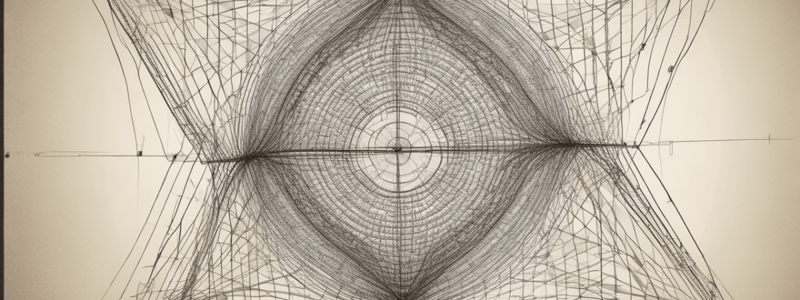Podcast
Questions and Answers
What is the general form of the sum of the first n terms of a sequence?
What is the general form of the sum of the first n terms of a sequence?
- ∑i=mTi
- ∏i=mTi
- S_n = T_n
- S_n = T_1 + T_2 + T_3 + … + T_n (correct)
What is the symbol used in sigma notation to denote the sum of terms in a sequence?
What is the symbol used in sigma notation to denote the sum of terms in a sequence?
- ∏
- Σ (correct)
- ∫
- ∂
What type of series sums infinitely many terms of a sequence?
What type of series sums infinitely many terms of a sequence?
- Infinite series (correct)
- Divergent series
- Convergent series
- Finite series
What does the index of summation represent in sigma notation?
What does the index of summation represent in sigma notation?
What is the term at index i in sigma notation?
What is the term at index i in sigma notation?
What is the difference between a finite series and an infinite series?
What is the difference between a finite series and an infinite series?
What does the summation symbol ∑ represent in sigma notation?
What does the summation symbol ∑ represent in sigma notation?
What is the purpose of the lower bound (m) in sigma notation?
What is the purpose of the lower bound (m) in sigma notation?
What is the expression for the sum of the first n terms of a sequence?
What is the expression for the sum of the first n terms of a sequence?
What is the primary difference between finite and infinite sequences?
What is the primary difference between finite and infinite sequences?
Flashcards are hidden until you start studying
Study Notes
Series
- A series is the sum of the terms of a sequence, which can be either finite or infinite.
Finite Series
- The sum of the first n terms of a sequence is denoted as S_n.
- S_n is calculated by adding the first n terms: T_1 + T_2 + T_3 + … + T_n.
Infinite Series
- An infinite series sums infinitely many terms of a sequence.
- The sum of an infinite series is denoted as S_∞.
Sigma Notation
- Sigma notation is a concise way to represent the sum of terms in a sequence.
- The summation symbol Σ (Greek letter S) is used to denote the sum.
- The general form of sigma notation is: ∑{i=m}^{n} T_i = T_m + T{m+1} + … + T_{n-1} + T_n.
Sigma Notation Components
- i is the index of summation.
- m is the lower bound (starting index).
- n is the upper bound (ending index).
- T_i is the term of the sequence at index i.
Series
- A series is the sum of the terms of a sequence, which can be either finite or infinite.
Finite Series
- The sum of the first n terms of a sequence is denoted as S_n.
- S_n is calculated by adding the first n terms: T_1 + T_2 + T_3 + … + T_n.
Infinite Series
- An infinite series sums infinitely many terms of a sequence.
- The sum of an infinite series is denoted as S_∞.
Sigma Notation
- Sigma notation is a concise way to represent the sum of terms in a sequence.
- The summation symbol Σ (Greek letter S) is used to denote the sum.
- The general form of sigma notation is: ∑{i=m}^{n} T_i = T_m + T{m+1} + … + T_{n-1} + T_n.
Sigma Notation Components
- i is the index of summation.
- m is the lower bound (starting index).
- n is the upper bound (ending index).
- T_i is the term of the sequence at index i.
Studying That Suits You
Use AI to generate personalized quizzes and flashcards to suit your learning preferences.



